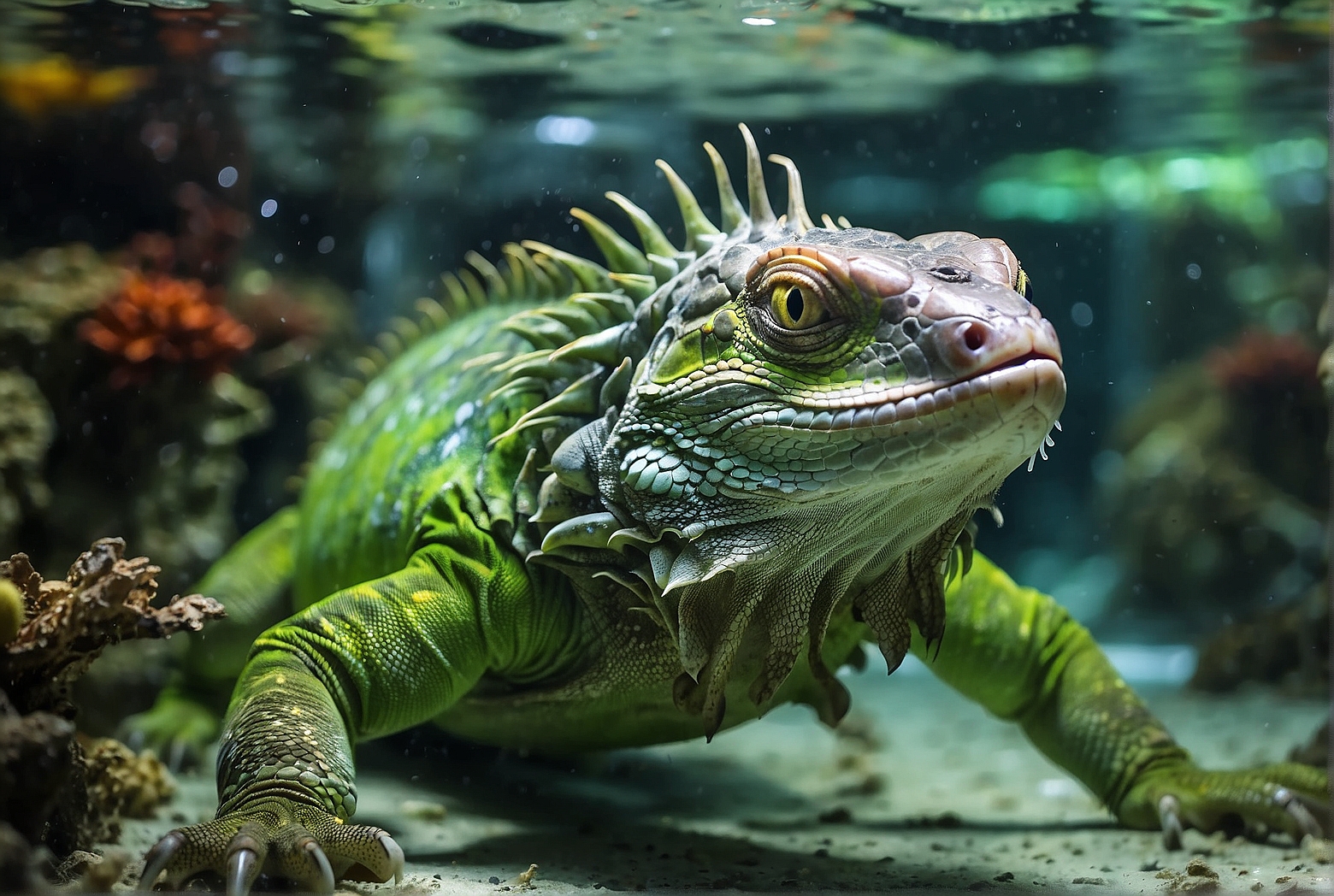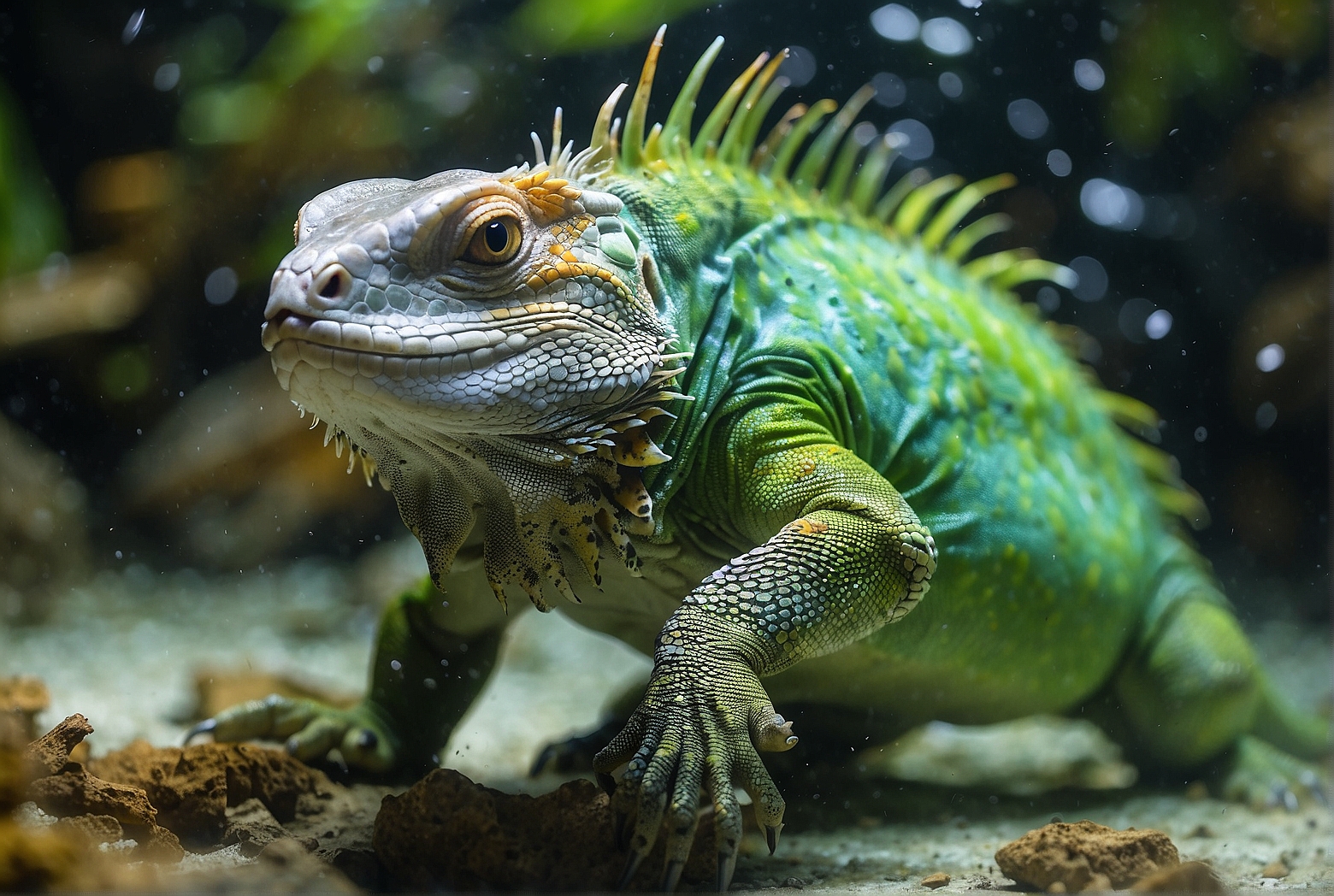Did you know that the graceful and vibrant green iguanas possess surprising underwater abilities? These reptiles, known for their arboreal lifestyle, are also highly skilled swimmers. Despite being primarily arboreal, green iguanas can hold their breath for an impressive amount of time, allowing them to explore the depths of the water and even catch their prey. The underwater prowess of these unique creatures is a testament to their adaptability and adds another fascinating layer to their already captivating behavior. So, let’s take a closer look at the underwater abilities of green iguanas and discover the hidden depths of their aquatic world.
The Underwater Abilities of Green Iguanas
Green iguanas, also known as American iguanas, possess remarkable adaptations that enable them to survive and thrive in aquatic environments. From their breath-holding capacity to their swimming techniques, these reptiles have developed a range of abilities for maneuvering underwater. In this article, we will explore the various adaptations of green iguanas for underwater survival, their breath-holding capacity, swimming techniques, how they hold their breath to evade predators, feed underwater, regulate their body temperature, communicate, maintain spatial awareness, navigate, and the potential dangers and limitations they face in these aquatic habitats.
Adaptations for Underwater Survival
Green iguanas have evolved several adaptations that contribute to their ability to survive in underwater environments. One of the key adaptations is their webbed feet. These specialized feet with interconnected skin allow green iguanas to paddle efficiently through water, providing them with excellent maneuverability. Their long tails also play a crucial role in underwater survival. The tail acts as a rudder, aiding in steering and enhancing their swimming abilities.
Another remarkable adaptation possessed by green iguanas is their flexible spines. This flexible spinal column allows for better agility and propulsion in water. Additionally, green iguanas utilize a cloacal valve to prevent water from entering their bodies while submerged. This adaptation is essential for maintaining buoyancy and preventing the inhalation of water during their aquatic ventures.
Breath-Holding Capacity
Green iguanas possess extraordinary breath-holding capacity, allowing them to stay submerged for extended periods. This ability is facilitated by various physiological adaptations. To maximize their time underwater, green iguanas can consciously reduce their heart rate, leading to decreased oxygen consumption. This, in turn, prolongs their ability to hold their breath without surfacing.
Several factors influence the duration of breath-holding in green iguanas. These factors include age, physical condition, and activity level. Younger individuals may have shorter breath-holding durations compared to adults due to their underdeveloped physiology. Furthermore, the metabolic demands during active swimming or other physical exertions can affect the duration of their breath-holding capabilities.

It is important to note that breath-holding capacity can vary among individual green iguanas. Some individuals may be able to hold their breath for several minutes, while others may have a relatively shorter duration. This variability is influenced by factors such as overall health, size, and genetic predisposition.
Swimming Techniques
Green iguanas employ a range of swimming techniques to navigate through water. Their primary means of propulsion is by utilizing their strong hind limbs. The powerful leg muscles allow them to forcefully push against the water, propelling them forward with remarkable speed and agility. The webbed feet contribute to the efficiency of their swimming technique, aiding in better grip and thrust in the water.
In addition to using their hind limbs, green iguanas also utilize their long tails for swimming. They employ lateral undulations of their muscular tail to generate propulsion. By flexing their spine and coordinating the movements of their limbs and tail, they achieve efficient swimming maneuvers.
Green iguanas exhibit impressive arm and leg coordination while swimming. The coordination between the limbs and tail allows for a synchronized movement, enabling agile navigation through the water. These coordinated movements contribute to their ability to change direction swiftly and evade potential predators.
Furthermore, green iguanas have been observed gliding in the water. By spreading out their limbs and using their tails for stabilization, they can maintain buoyancy and glide effectively, conserving energy while submerged.
Holding Breath to Evade Predators
Green iguanas have developed various strategies to hold their breath and evade predators while submerged. When threatened, they may exhibit freezing behavior, remaining motionless in the water to avoid detection. This behavior aids in camouflage, as their green coloration helps them blend in with the surrounding vegetation and makes them less visible to predators.

In addition to freezing behavior, green iguanas may dive and hide from predators underwater. By submerging themselves in areas with dense underwater vegetation or utilizing natural structures, such as rocks or fallen logs, they can find refuge and remain concealed until the threat passes. This ability to quickly dive and hide is crucial for their survival in aquatic habitats.
Another interesting defense mechanism displayed by green iguanas is playing dead. When confronted by a predator in the water, they may mimic a lifeless state, floating motionlessly on the surface. This behavior can deceive predators, making them less likely to pursue the seemingly lifeless prey.
Feeding Underwater
Green iguanas exhibit a diverse feeding behavior, including feeding underwater. While their diet primarily consists of plant material such as leaves, flowers, and fruits, they also opportunistically prey on small animals. When feeding underwater, green iguanas primarily consume aquatic plants. Their ability to stay submerged for extended periods allows them to actively forage and graze on underwater vegetation.
Green iguanas employ suction feeding when consuming underwater plants. By creating a vacuum with their mouth, they can draw in water and ingest the desired plant material. This feeding technique allows them to efficiently gather the necessary nutrients from underwater plant sources.
Temperature Regulation
Green iguanas utilize various mechanisms to regulate their body temperature while in aquatic environments. When the temperature rises, they employ a cooling-off technique by submerging themselves in water. By immersing their bodies in cooler water, they can dissipate excess heat and maintain a stable body temperature.
Basking behavior also contributes to temperature regulation in green iguanas. After swimming or foraging underwater, they often bask in the sun on rocks or branches. This behavior aids in thermoregulation by allowing their bodies to absorb heat from the sun, raising their internal temperature to optimal levels.
Green iguanas may also seek thermal refuges while underwater. These thermal refuges can include underwater crevices or pockets of water with different temperature gradients. By navigating within their aquatic habitat, green iguanas can find these thermal refuges, providing them with the opportunity to regulate their body temperature more effectively.
Underwater Communication
Green iguanas utilize various modes of communication while in underwater environments. Visual cues play a crucial role in their communication repertoire. Through specific body postures, gestures, or movements, green iguanas can convey information to conspecifics or potential predators. These visual cues may serve to establish dominance, defend territories, or signal reproductive readiness.
In addition to visual communication, green iguanas can produce vocalizations while submerged. These vocalizations may be used to communicate with other individuals or signal potential threats. However, the extent and complexity of their underwater vocalizations are still areas of ongoing research.
Body movements also contribute to their underwater communication. By utilizing specific swimming patterns or tail flicks, green iguanas can convey messages to conspecifics or indicate their intentions. These body movements, combined with visual cues and vocalizations, create a comprehensive underwater communication system for green iguanas.
Spatial Awareness
Green iguanas have developed remarkable spatial awareness underwater, allowing them to navigate and interact with their environment effectively. One way they achieve spatial awareness is through the use of vibrations. By detecting subtle vibrations in the water, green iguanas can identify the presence of nearby objects, potential predators, or other individuals.
Sense of smell also contributes to their spatial awareness. Green iguanas possess a highly developed sense of smell, enabling them to detect chemical cues in the water. This sense allows them to locate food sources, navigate through their habitat, and differentiate potential predators from non-threatening stimuli.
Furthermore, green iguanas exhibit a certain level of depth perception underwater. Their visual acuity and ability to gauge distances aid in their spatial awareness, helping them navigate through complex underwater environments accurately.
Underwater Navigation
Green iguanas demonstrate impressive navigational abilities in underwater environments. Their adeptness in swimming techniques allows them to traverse through water with great precision. By utilizing their hind limbs, tail, and limbs in a coordinated manner, they can maneuver efficiently, changing direction swiftly if needed.
Additionally, green iguanas employ their spatial awareness skills, such as detecting vibrations and utilizing their sense of smell, to navigate underwater. These sensory abilities assist them in locating desired foraging areas, identifying potential threats, and ensuring they maintain a sense of direction within their aquatic habitat.
Dangers and Limitations
While green iguanas possess exceptional underwater abilities, they are not without their share of dangers and limitations. One primary concern for green iguanas in aquatic habitats is the presence of predators. Despite their adaptations for underwater survival, they can still fall victim to larger aquatic predators, such as caimans or snakes.
Another limitation green iguanas face is the limited oxygen supply while submerged. Although they possess the ability to hold their breath for extended periods, there are limitations to how long they can stay underwater. Like all reptiles, green iguanas rely on oxygen-rich air and need to resurface periodically to replenish their oxygen levels.
Challenges also arise when green iguanas venture into saltwater environments. The higher salt content in these habitats can pose difficulties in maintaining proper hydration and electrolyte balance. Therefore, green iguanas typically prefer freshwater or brackish environments.
Lastly, there is always a risk of injuries when green iguanas navigate and engage in underwater activities. Collisions with rocks, branches, or other obstacles may occur, leading to potential injuries or impaired swimming ability.
In conclusion, green iguanas showcase an impressive array of adaptations and abilities for underwater survival. From their webbed feet and flexible spines to their breath-holding capacity and swimming techniques, these reptiles have evolved numerous traits to thrive in aquatic environments. Their underwater capabilities also include holding their breath to evade predators, feeding underwater, regulating their body temperature, communicating, maintaining spatial awareness, and navigating through their habitat. While they face certain dangers and limitations, green iguanas have successfully adapted to their underwater lifestyles and continue to thrive in their aquatic habitats.
